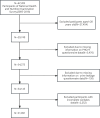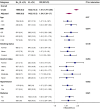The association between urinary incontinence and suicidal ideation: Findings from the National Health and Nutrition Examination Survey
- PMID: 38781254
- PMCID: PMC11115289
- DOI: 10.1371/journal.pone.0301553
The association between urinary incontinence and suicidal ideation: Findings from the National Health and Nutrition Examination Survey
Abstract
Background: Urinary incontinence (UI) might be linked to suicidal ideation, but we do not yet have all the relevant details. This study aimed to dig deeper into the connection between UI and suicidal ideation using data from the National Health and Nutrition Examination Survey (NHANES).
Methods: We examined 31,891 participants aged ≥ 20 years from NHANES 2005-2018 who provided complete information. We used standardized surveys to check for UI and signs of suicidal ideation. To better understand this relationship, we used statistical tools such as multivariable logistic regression, subgroup analysis, and sensitivity analyses.
Results: Among the 31,891 participants, 28.9% reported UI and 10.7% reported suicidal ideation. Those with UI exhibited a significantly greater incidence of suicidal ideation (15.5%) than did those without UI (8.8%, P < 0.001). After adjusting for various factors, including age, sex, marital status, socioeconomic status, educational level, lifestyle factors, and chronic comorbidities, UI remained significantly associated with suicidal ideation (OR:1.54, 95% CI = 1.39-1.7, P < 0.001). Among all types of UI, MUI participants were more likely to experience suicidal ideation. Compared with no UI, higher odds of suicidal ideation suffered from MUI (OR:2.11, 95%CI:1.83-2.44, P < 0.001), SUI (OR:1.4, 95%CI:1.19-1.65, P < 0.001), UUI(OR:1.37,95%CI:1.16-1.62, P < 0.001) after full adjustment. With the exception of individuals living with a partner, the remaining subgroups exhibited a positive correlation between urinary incontinence and suicidal ideation, considering that factors such as age, sex, and prevalent comorbidities such as hypertension, depression, and diabetes did not reveal any statistically significant interactions (all P > 0.05). Sensitivity analyses, incorporating imputed missing covariates, did not substantially alter the results (OR: 1.53, 95% CI: 1.4-1.68, P < 0.001).
Conclusion: Urinary incontinence may correlate with increased suicidal ideation risk, priority screening for suicidal ideation and timely intervention are essential for individuals with urinary incontinence, but prospective studies are needed to verify the results.
Copyright: © 2024 Pan et al. This is an open access article distributed under the terms of the Creative Commons Attribution License, which permits unrestricted use, distribution, and reproduction in any medium, provided the original author and source are credited.
Conflict of interest statement
The authors have declared that no competing interests exist.
Figures
Similar articles
-
Association between triglyceride glucose body mass index and urinary incontinence: a cross-sectional study from the National Health and Nutrition Examination Survey (NHANES) 2001 to 2018.Lipids Health Dis. 2024 Sep 20;23(1):304. doi: 10.1186/s12944-024-02306-7. Lipids Health Dis. 2024. PMID: 39304881 Free PMC article.
-
Weight-adjusted-waist index is positively associated with urinary incontinence: results from the National Health and Nutrition Examination Survey (NHANES) 2001-2018.Eur J Med Res. 2024 Jul 16;29(1):368. doi: 10.1186/s40001-024-01971-9. Eur J Med Res. 2024. PMID: 39014459 Free PMC article.
-
Urinary incontinence and its relationship to mental health and health-related quality of life in men and women in Sweden, the United Kingdom, and the United States.Eur Urol. 2012 Jan;61(1):88-95. doi: 10.1016/j.eururo.2011.07.049. Epub 2011 Jul 26. Eur Urol. 2012. PMID: 21831517
-
The Interaction Effect of Obesity with Sleep Duration on Urinary Incontinence in Adult Females: A Cross-Sectional Study of the NHANES Database.Urol Int. 2024;108(6):525-538. doi: 10.1159/000540094. Epub 2024 Jul 24. Urol Int. 2024. PMID: 39047704
-
Incidence and risk factors for postoperative urinary incontinence after various prostate enucleation procedures: systemic review and meta-analysis of PubMed literature from 2000 to 2021.World J Urol. 2022 Nov;40(11):2731-2745. doi: 10.1007/s00345-022-04174-1. Epub 2022 Oct 4. World J Urol. 2022. PMID: 36194286
Cited by
-
Association between phenotypic age and mortality risk in individuals with obesity: a retrospective cohort study.Front Public Health. 2024 Dec 9;12:1505066. doi: 10.3389/fpubh.2024.1505066. eCollection 2024. Front Public Health. 2024. PMID: 39717032 Free PMC article.
-
Association between the dietary index for gut microbiota and atherosclerotic cardiovascular disease risk among US elderly adults: a cross‑sectional study.Nutr J. 2025 May 11;24(1):77. doi: 10.1186/s12937-025-01141-5. Nutr J. 2025. PMID: 40350409 Free PMC article.
-
Association of a newly proposed dietary index for gut microbiota with phenotypic age acceleration: a cross-sectional study of NHANES 1999-2018.J Health Popul Nutr. 2025 Jul 12;44(1):251. doi: 10.1186/s41043-025-01007-w. J Health Popul Nutr. 2025. PMID: 40652280 Free PMC article.
-
Urinary incontinence and subjective well-being among Chinese old adults: the multiple mediation effect of social participation and sleep quality.BMC Geriatr. 2025 Jul 8;25(1):503. doi: 10.1186/s12877-025-06174-3. BMC Geriatr. 2025. PMID: 40629327 Free PMC article.
-
Effect of lattice CO2 laser combined with Kegel exercise mild moderate stress urinary incontinence and postpartum depression anxiety.World J Psychiatry. 2025 Mar 19;15(3):103252. doi: 10.5498/wjp.v15.i3.103252. eCollection 2025 Mar 19. World J Psychiatry. 2025. PMID: 40110007 Free PMC article.
References
-
- National suicide prevention strategies: progress, examples and indicators. [cited 24 Dec 2023]. Available: https://www.who.int/publications-detail-redirect/national-suicide-preven....
-
- Nations U. Prevention of suicide: Guidelines for the formulation and implementation of national strategies. United Nations; New York; 1996.
-
- Comprehensive Mental Health Action Plan 2013–2030. [cited 27 Feb 2024]. Available: https://www.who.int/publications-detail-redirect/9789240031029.
MeSH terms
LinkOut - more resources
Full Text Sources
Medical



